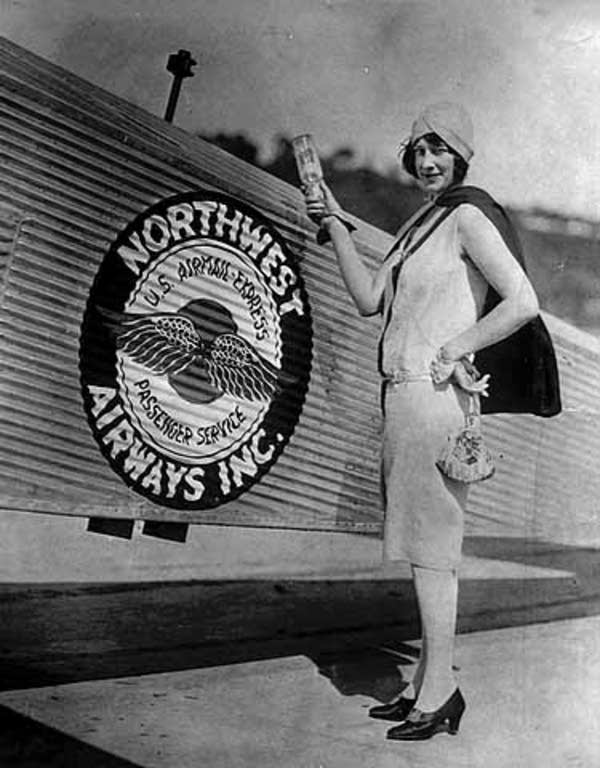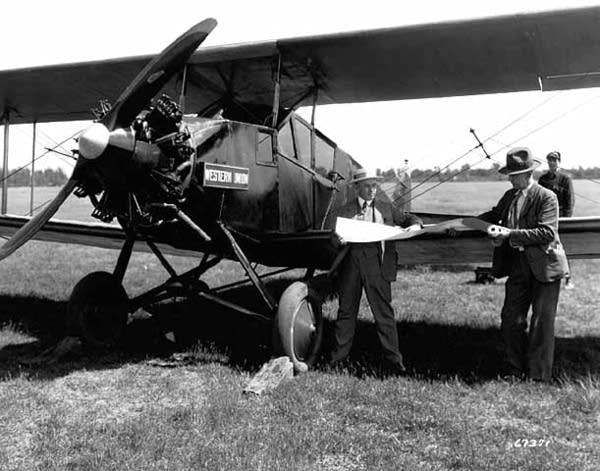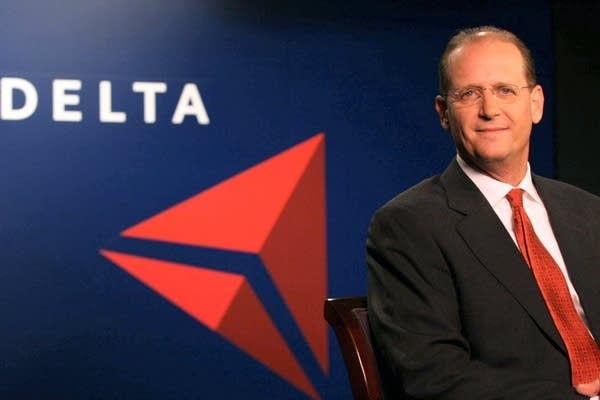Northwest Airlines -- a look back at its long history
Go Deeper.
Create an account or log in to save stories.
Like this?
Thanks for liking this story! We have added it to a list of your favorite stories.

Among Minnesota companies, few can match Northwest for its longevity or impact on the state's economy and citizens. Northwest is in the same league as a 3M or Cargill.
Of course, Northwest has been often ridiculed by many of its customers and employees. The airline's failings have always been very public, making Northwest a favorite target of comedians -- and the media -- who've lampooned the airline for everything from boozing pilots to a flight that ends up at the wrong airport.
Who can forget Northwest's advice to laid-off employees, in the form of a tip sheet on how to cut living expenses -- rummage through other people's trash.
Northwest apologized for the suggestion. Profusely.
Turn Up Your Support
MPR News helps you turn down the noise and build shared understanding. Turn up your support for this public resource and keep trusted journalism accessible to all.
'AN INCREDIBLE ASSET'
Sometimes Northwest has deserved scorn. Sometimes it hasn't. But Northwest has arguably been often under-appreciated, especially by Minnesotans.

Northwest's hub airport in the Twin Cities has given the region an extraordinary level of air service, particularly overseas. Far better than what most other comparably-sized markets in the country enjoy.
Northwest is an extremely valuable asset," said former Minnesota Gov. Arne Carlson. "It has to be certainly one of our top five."
Former governor Arne Carlson says Northwest's air service has been very important to Minnesota's economy as business has grown more global.
"You can literally leave Minneapolis and be in Asia, be in Europe, via a direct flight. And that's an incredible asset," said Carlson.
In addition to providing an essential service, Northwest has provided tens of thousands of Minnesotans with good-paying jobs.

The airline has been an industry pioneer in the deployment of everything from oxygen masks to radar. And attention, non-smokers, Northwest was the first airline to snuff out smoking on all domestic flights, back in 1988.
From the Twin Cities, Northwest flies to La Crosse and London, Tulsa and Tokyo, Portland and Paris, and some 150 other destinations. All non-stop.
Many travelers have groused about Northwest's fares. But most choose to fly Northwest even when they have cheaper alternatives.
FIRST FLIGHT
Northwest got started in 1926, when Col. Lewis Brittin founded Northwest Airways with operations based at Speedway flying field, now the site of Minneapolis St. Paul International Airport.
Northwest started out carrying airmail from the Twin Cities to Chicago. The carrier's fleet consisted of two rented, open-cockpit biplanes.

In July 1927, Northwest's first passenger flight took off for Chicago. A one-way ticket cost $40, which would be nearly $500 today. The flight took 12 1/2-hours, including stops in La Crosse, Madison, and Milwaukee.
Back in those days, pilots wore goggles, leather hats and long leather trench coasts. Flying was a true adventure.
"We had no radio. We had nothing," recalled Joe Kimm, one of Northwest's first pilots. "We had an airplane we knew how to fly, and that was it."
Kimm was 18 years old when he started to fly for Northwest in 1930.
"We were on our own. If the weather got bad, we just had to stop where we were and wait until it got better. We would usually fly into a farmer's field, circle it to make sure there wasn't a haystack in the middle of it, and land," said Kimm. "Take our mail and put it on the train. Passengers if we had any, also on the train. And we would sit it out for a day or two till the weather got better and we could get out of there."
TO THE ORIENT
In the summer of 1947, Northwest began service from the Twin Cites to Tokyo, Seoul, Shanghai and Manila. Northwest would grow to become a major player in the Pacific. And the airline took on a new name -- Northwest Orient.

The expansion to Asia and launch of transcontinental service marked the start of a golden era for the airline. One that ran from the 1950s to the '70s.
But the airline industry changed radically in the late '70s when it was deregulated. Federal regulators lifted restrictions on routes and pricing, creating an intense battle for customers.
New airlines were born. Old ones died. Many looked to find partners to strengthen themselves.
By 1984, Northwest was the leading U.S. carrier in the Pacific. But Northwest executives felt they had to get bigger. They wanted a stronger domestic route system that could feed passengers to Northwest's Pacific flights.
Steve Rothmeier, Northwest's CEO at the time, said the need to act was urgent.
"The world is changing quickly. The competitive marketplace is dictating a lot of action that, in the past, probably would have been considered rather unusual for Northwest," said Rothmeier at the time.
MERGER NO. 1 DID NOT GO WELL
Rothmeier found a partner right here in the Twin Cities -- Republic Airlines.

At the time, Northwest's $884 million purchase of Republic was the largest merger in airline history. The combination of Northwest and Republic assured the Twin Cities would have extensive air service. Without the merger, neither airline may have survived.
But the merger was hard for employees, passengers and the airline, especially for the first five months or so. The airline ran into a series of operational snafus and employees bickered constantly.
In a video prepared for sales managers, vice president of ground operations Brent Baskfield acknowledged things were going pretty badly.
"Our on-time performance started out very poorly. It was running at 42 percent," said Baskfield. "We've had some real problems with lost bags. We've had problems with unions vs. unions. Unions vs. supervision. Northwest vs. Republic. But maybe worst of all, we've had a serious attitude problem."
Before the merger was a year old, catastrophe struck. In August 1987, a Northwest MD-80 jet crashed in Detroit as it attempted to take off. An eyewitness described the scene.

"Within seconds the flames got bigger, and the plane was on fire, and seconds after that it exploded. Great big explosion. It was airborne, but it was having troubles, and we looked and it was on fire."
It was the worst accident in Northwest's history -- 156 people died in the crash. One child survived.
Still, by the end of the 1980s, Northwest was firmly established as one of the country's big international airlines. And its potential was getting noticed.
THE AL CHECCHI ERA
"Just think what we can do with this company if we start to increase its service levels," said Al Checchi in 1989.
In June of that year, Checchi's investment group acquired Northwest for $3.5 billion and took the airline private.
In an in-house interview, Checchi was very optimistic about Northwest's financial prospects and turning around its historically stormy labor relations.
"It'll be a whole lot more fun for employees. One thing I've learned about the service business and service employees is they want to serve -- they want to make customers happy," Checchi said at the time. "And if you can give customers better service, you'll have employees who are much more excited."
But the next few years weren't very much fun at Northwest.
In both 1990 and 1991 Northwest lost more than $300 million. In 1991, the airline launched an all-out lobbying campaign for state financial assistance and guarantees.
THE STATE STEPS IN TO SAVE THE AIRLINE
With Christmas of 1991 less than two weeks away, a legislative commission approved the final elements of a deal amid heated debate. Supporters hailed the package, But critics decried it as a fraud, a bailout and blackmail.
Ultimately, the deal wasn't enough to shore up the airline's finances. By 1993, Northwest was threatening to file for bankruptcy because of a crippling debt load from the buyout.
Employees gave wage and other concessions, which planted the seeds for more labor unrest. In August and September of 1998, a pilot strike grounded the airline for more than two weeks.
Northwest recovered from the strike. But its fortunes started slipping again in 2000, as the dot.com bubble popped and business travel plunged.
2001 BEGINS A DIFFICULT PERIOD
Then came 9/11. The Sept. 2001 terror attacks sent Northwest and other carriers into a steep nosedive. The demand for air travel fell even more.
Northwest's CEO at that time, Richard Anderson, cut 10,000 jobs, about half them in Minnesota.
"Next to watching the horrific events of Sept. 11 on television, the next most difficult thing for all of us at Northwest is the impact it has on the people's lives at Northwest," said Anderson at the time.

The following years were some of the most difficult in the airline's history. They included billions of dollars in losses, a strike that crushed the mechanics' union, and a bankruptcy filing in 2005.
Northwest used the reorganization process to slash wages and other costs, dump unwanted planes, and otherwise reinvent itself. It emerged from bankruptcy in May 2007.
At the time, CEO Doug Steenland said Northwest Airlines' Twin Cities headquarters and hub were here to stay.
"We sort of re-said our vows. We are blessed to have the opportunity to be an airline in the Twin Cities," said Steenland at the time. "It has a strong economy, and our customers here have been very good to us. We have no intention to do anything here but hopefully be able to grow the hub."
THE DEAL WITH DELTA ENDS AN ERA
By last fall though, with fuel prices soaring, Steenland was talking about the possibility of merging Northwest with another airline. That deal -- with Delta -- was announced in April.

Despite Northwest's turbulent history with its customers and employees, former Gov. Arne Carlson gives the airline high marks.
"Northwest overall has done as good a job as could be done under very, very difficult circumstances," said Carlson. "If somebody said, 'Arnie, we'd love you to be a CEO,' I'll tell you, I'd pay anything not to be a CEO of an airline."
For Delta CEO Richard Anderson, the job is likely to be even more challenging.
Anderson, who used to run Northwest, has to combine his new company with his old one and avoid the pitfalls of the Northwest-Republic merger of two decades ago.
With Delta closing its acquisition of Northwest this week, it is now the world's biggest airline. Northwest's signature red tail will start disappearing from the skies in 2009, as the planes are repainted in Delta's colors.






